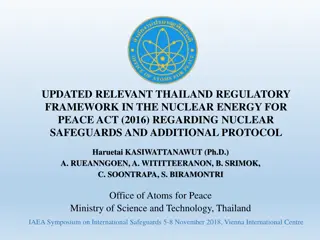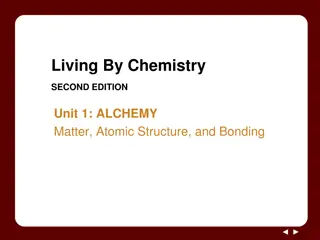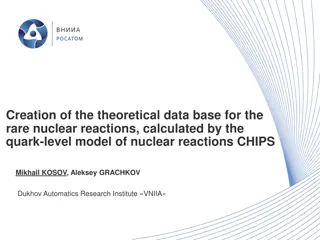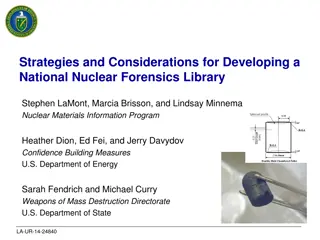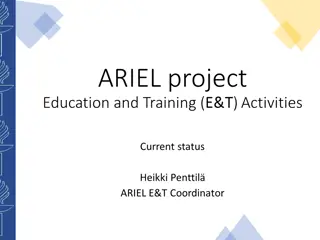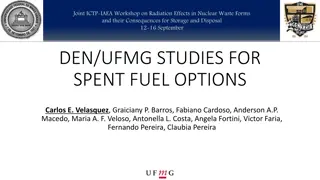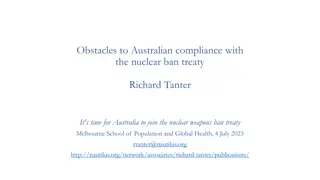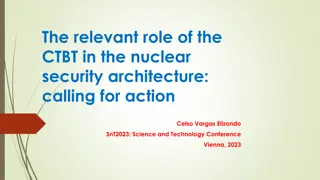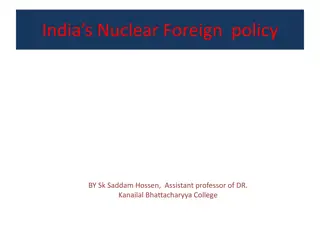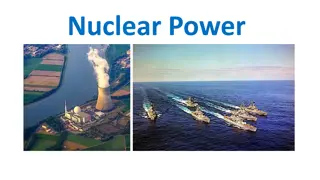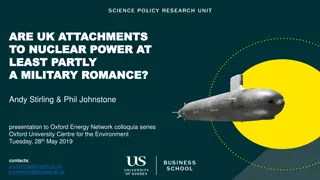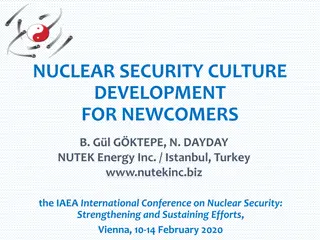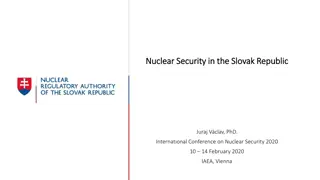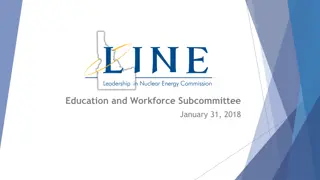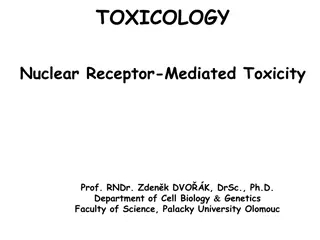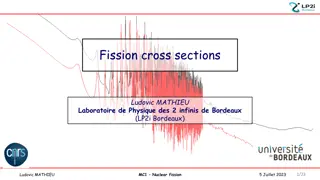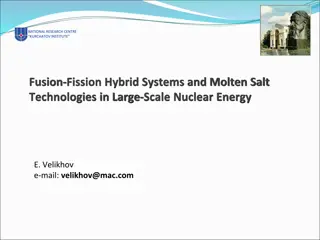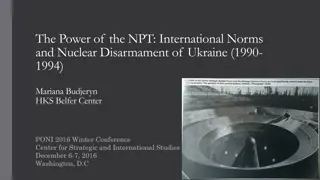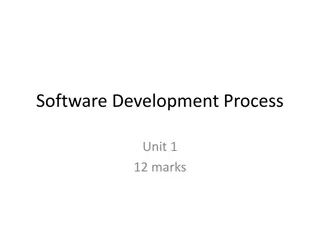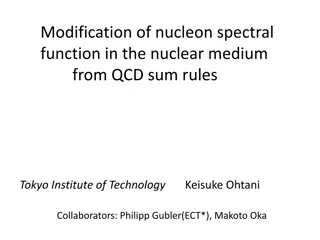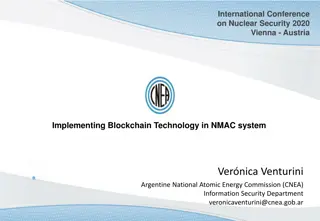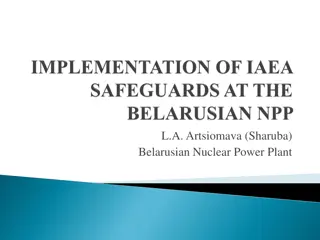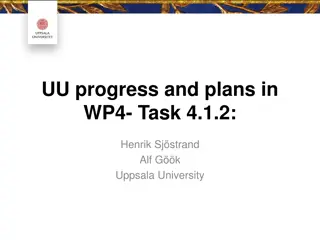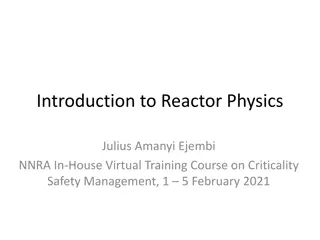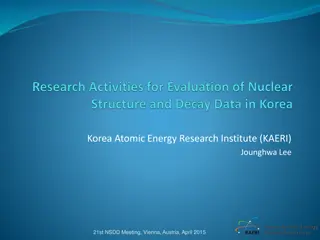Evaluation of Critical Non-Nuclear Material Balance Using COSI Software
Emerging technologies have led to a demand for critical materials, defined based on supply risk and economic importance. The COSI software evaluates non-fissile material balance, focusing on materials labeled as critical for the EU economy. The concept of criticality considers factors like political stability, production concentration, and recycling rates. Initial evaluations in 2010 identified 14 critical raw materials, with subsequent revisions in 2014 and 2017 updating the list based on supply risks and economic impacts.
Download Presentation

Please find below an Image/Link to download the presentation.
The content on the website is provided AS IS for your information and personal use only. It may not be sold, licensed, or shared on other websites without obtaining consent from the author. Download presentation by click this link. If you encounter any issues during the download, it is possible that the publisher has removed the file from their server.
E N D
Presentation Transcript
COSI Evaluation of non-nuclear material balance with the COSI software CEA SPRC | Philippe MIRANDA 3rd Technical Workshop on Fuel Cycle Simulation (9 - 11 juillet 2018) | PAGE 1 CEA | 18 septembre 2013
Overview Emerging technologies raise up. So, a new demand appeared for some material called critical. Critical materials are defined according to EU criteria. A new developpement in COSI (CEA scenario software) evaluates the non-fissile material balance. Definitions : In different studies and policies, the term "strategic" is often used instead of "critical" raw materials. The definitions used reveal that : the materials for military use are called strategic", the materials for which a threat to the supply could imply harm to the national economy are considered "critical". Therefore, the term "critical" will be used in this report. | PAGE 2 3rd Technical Workshop on Fuel Cycle Simulation CEA | 9-11 july 2018
Methodology The concept of criticality consider the supply risk vs economic importance : the "supply risk" takes into account : the political and economic stability of the producing countries, the level of concentration of production, the potential for substitution the rate of recycling. the protection measures taken by producing countries (restrictions, quotas ). the economic importance aims at providing insight into the importance of a material for the EU economy in terms of end-use applications and the value added (VA) of EU manufacturing sectors. This means that the raw material is labeled "critical" when the risks of supply shortages and their impact on the economy are higher than most other commodities. | PAGE 3 3rd Technical Workshop on Fuel Cycle Simulation CEA | 9-11 july 2018
First Evaluation 2010 Critical raw materials for the EU (30 July 2010) In this first report, 14 raw materials are labeled "critical" : Antimony Indium Beryllium Magnesium Cobalt Niobium Fluorspar PGMs (Platinum Group Metals) Gallium Rare earths Germanium Tantalum Graphite Tungsten | PAGE 4 3rd Technical Workshop on Fuel Cycle Simulation CEA | 9-11 july 2018
First Evaluation 2010 | PAGE 5 3rd Technical Workshop on Fuel Cycle Simulation CEA | 9-11 july 2018
Next Evaluations 2014/2017 The Commission has undertaken to revise and update, at least every three years, this list of critical raw materials for the European Union : In 2014, tantalum was removed from the list (due to a lower risk of supply shortage). Six new raw materials have been added : borates, chromium, coking coal, magnesite, phosphate rock silicon metal. In 2017, the new list includes nine new materials : baryte, bismuth, hafnium, helium, natural rubber, phosphorus, scandium, tantalum, vanadium | PAGE 6 3rd Technical Workshop on Fuel Cycle Simulation CEA | 9-11 july 2018
Critical Matrix 2017 Evaluations 2013/2017 | PAGE 7 3rd Technical Workshop on Fuel Cycle Simulation CEA | 9-11 july 2018
Exemples of Risk Analysis Risk analysis for Magnesium : EU imports nearly 47% of the world's magnesium production. China is by far the largest producer of magnesium in the world, with nearly 93% of global production China, Russia and South Africa impose trade restrictions Recycling opportunities for magnesium are limited Risk analysis for Rare Earths : China accounted for 97% of global production in 2009. In addition, China applies export restrictions and quotas for rare earths. New mining projects are underway in other countries, but in addition to the time required to (re) open a mine for production, rare earth mining is particularly complex. Although rare earth recovery processes have been developed, none of them are currently commercially viable. For most applications, rare earth substitutes are available, but with a loss of performance. | PAGE 8 3rd Technical Workshop on Fuel Cycle Simulation CEA | 9-11 july 2018
COSI Method Use the fuel balance to evaluate the number of each kind of irradiated assemblies, for each reactor. Knowing the composition of each assembly, the structure materials balance is assessed for the whole reactor lifetime and the complete french fleet. Analyse the mass balance : criticality ? | PAGE 9 3rd Technical Workshop on Fuel Cycle Simulation CEA | 9-11 july 2018
Results : mass balance Structure materials in the French fleet (steels) 1977 2090 : PWR AISI 302 AISI 304 AISI 304L AISI 308 AISI 308L AISI 316L AISI 660 Alliage M5 Alliage X750 CF-3 Q12 Inconel 600 Alliage 718 Zy 4 Total (tons) 445 695 1229 0 0 69 40 8306 16 74 2 365 11167 22410 | PAGE 10 3rd Technical Workshop on Fuel Cycle Simulation CEA | 9-11 july 2018
Results : mass balance Astrid demonstrator (Boron and Magnesium) 2023 2082 : Mass balance (tons) : B4C-nat B4C-48% MgO W 118,5 17,2 175,1 2,6 Are these amounts critical ? | PAGE 11 3rd Technical Workshop on Fuel Cycle Simulation CEA | 9-11 july 2018
Conclusions - Perspectives For the first time, we use the software COSI, intended to fuel cycle computation, to assess a critical material balance. Critical materials are very dependent on the geopolitical and industrial situations. The critical materials list must be updated regularly. This work enables the analysis of supply problems (resources, costs, production capacity, transformation), economic analysis of expenses and cost optimization. | PAGE 12 3rd Technical Workshop on Fuel Cycle Simulation CEA | 9-11 july 2018
Thanks for your attention | PAGE 13 DEN DER SPRC Commissariat l nergie atomique et aux nergies alternatives Centre de Cadarache | 13108 Saint Paul Lez Durance Cedex T. +33 (0)4 42 25 31 30 | F. +33 (0)4 42 25 48 49 CEA | 18 septembre 2013 Etablissement public caract re industriel et commercial | RCS Paris B 775 685 019







